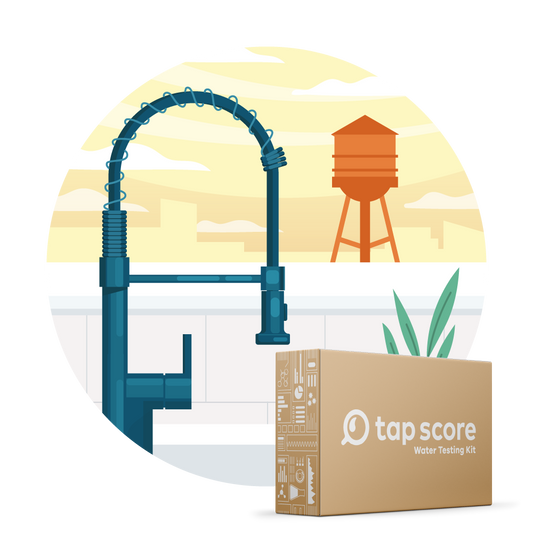
Quick Guide: Nitrate and Drinking Water
Our blog is written by real experts— not AI. Each guide is carefully reviewed and updated based on the latest research. Plus, with no affiliate links, you can count on unbiased insights you can trust.
Nitrate (and nitrite) in drinking water supplies can pose serious health risks, especially for infants and pregnant people. Nitrate is typically a problem for well owners, and there are a few routes by which nitrate can enter your water supply. Testing your water is the only way to determine your drinking water’s nitrate concentrations.
In this quick guide to nitrate, we’ll go over what it is, why it’s a problem, and what you can do to test and treat your drinking water.
Table of Contents:
- What Is Nitrate?
- How Does Nitrate Get Into Tap Water?
- What Are the Health Effects of Nitrate and Nitrite?
- What Are Safe Nitrate Levels in Drinking Water?
- Can I Test My Water for Nitrate?
- Do Water Filters Remove Nitrate?
- What’s the Takeaway?
What Is Nitrate?
Nitrate (and nitrite) are both naturally occurring compounds of nitrogen and oxygen (nitrates or nitrites refer to compounds that include nitrate or nitrite). They are naturally produced in soil by nitrifying bacteria, and in the bodies of animals. Plants and animals both require nitrates for growth and survival.
As far as human activities are concerned, both compounds are an important component of fertilizers and therefore most associated with the agriculture industry. Nitrate is also used in food preservatives, the manufacturing of explosives, and certain pharmaceuticals.
As nitrogen-containing organic matter, such as animal waste, is broken down by microbes through a process called “nitrification,” part of the nitrogen cycle, nitrite is converted into nitrate. Although nitrite can also contaminate drinking water, most nitrite present in water is rapidly converted to nitrate. For this reason, we talk about “nitrate contamination,” which includes nitrite as a source.
How Does Nitrate Get Into Tap Water?
Nitrate can enter your drinking water from a variety of sources, including agricultural runoff and wastewater discharges. Your likelihood of exposure will differ based on whether you get your water from a municipal water system or a private well.
Private Wells
If your well is near any of the following, your water supply has a higher probability of nitrate contamination:
- Livestock or animal feed farms
- A septic system
- Large agricultural operations
- Properties that fertilize excessively*
*Nitrate and nitrite are readily mobilized in water. Excess amounts of fertilizer applied to land for growing crops, along with livestock manure, can release nitrate into the surrounding soil and water, causing them to seep into the groundwater pumped up by wells.
Surveys by the USGS found that one quarter of the shallow wells tested underneath or nearby heavily farmed areas were contaminated above the EPA limit (10 PPM).[3]
How Does Agriculture Pollute Private Wells?
Public Water Systems
While private wells pose the highest risk of nitrate contamination, exposure to nitrate in public water systems is still common. The Environmental Working Group found that nitrate contamination in some of the country’s most impacted water systems has actually been increasing (according to an analysis of water quality results from 2003 to 2017).[2]
Water systems often rely on their own groundwater wells for source water, meaning nitrate enters water treatment plants similarly to the way they might enter a private well. Adding to that, smaller treatment plants—typically those in rural areas where nitrate is most prevalent—often lack the infrastructure or funds to completely remove nitrate from water before it reaches customers.
How Do I Know If There Is Nitrate or Nitrite in My Drinking Water?
The only way to know if nitrate or nitrite are in your drinking water is to have it tested by a certified laboratory. Nitrate and nitrite cannot be seen, smelled, or tasted.
Tap Score offers award-winning mail-in water testing kits that pair your water sample with a nationwide network of certified laboratories. Our helpful customer support team is there to guide you every step of the way. This specialized test offers targeted, high-resolution testing of nitrate in drinking water:
What Are the Health Effects of Nitrate and Nitrite?
While there are a number of potential human health risks associated with nitrate, methemoglobinemia (also known as “blue baby syndrome”) is the most established and perhaps most dangerous.

Methemoglobinemia
The presence of nitrate or nitrite in the body can interfere with the oxygen-carrying capacity of the blood, especially in infants. The human body naturally reduces nitrate to nitrite. Nitrite then converts normal hemoglobin, a protein in blood that transports oxygen to bodily tissues, to methemoglobin, which cannot transport oxygen.
- Symptoms include shortness of breath and blueness of the skin.
- Blue baby syndrome is also a risk to fetuses in utero, so expecting parents are encouraged to test their water for nitrate—especially if they live near agriculture and/or rely on private wells.
Expecting a Child? New Parents' Guide to Water Testing
Other potential health risks associated with nitrate in drinking water have limited and uncertain evidence; these other potential risks include thyroid issues, birth defects, and cancer.
Note: If your water test reveals you have nitrate in your drinking water source and you have an infant in the house, do not feed your infant formula with the drinking water.
Is Water High In Nitrate Dangerous to Shower or Bathe In?
No, it’s not dangerous to shower or bathe in water with higher than acceptable nitrate concentrations because nitrate is not absorbed by skin. Nitrate is only a concern for ingestion.
People looking to treat nitrate often do so at the kitchen sink, where water is used for cooking and drinking.
What Are Safe Nitrate Levels in Drinking Water?
The Environmental Protection Agency (EPA) has established Maximum Contaminant Levels (MCLs) and Maximum Contaminant Level Goals (MCLGs) for nitrate and nitrite:
- Nitrate (as N): 10 PPM MCL & MCLG
- Nitrite (as N): 1 PPM MCL & MCLG
Other countries, however, have developed standards that are stricter.
Can I Test My Water for Nitrate?
Absolutely—testing your water is the only way to know if nitrate is in your water and at what concentrations. But you want to be sure you’re having your water tested by a certified laboratory.
Do-it-yourself water test strips are not an adequate replacement for laboratory analysis. By design, test strips cannot replace the kind of detailed information specialized laboratory equipment provides on the concentrations of hazardous contaminants.
Private Wells
The Essential Well Water test is the best entry-level test kit to learn about the nitrate situation in your groundwater as well as other key contaminants for well owners. Recommended as your annual well test.
The Extended Well Water test gives you the most expansive and comprehensive picture of your well’s water quality. Recommended every few years.
Public Water Systems
The Advanced City Water test provides detailed analysis about a host of key contaminants customers of public utilities might encounter, including nitrates.
Do Water Filters Remove Nitrate?
Yes, certain water filters remove nitrate from drinking water. If your water test shows you have nitrate in your drinking water, you may want to treat your water by installing an at-home treatment system. Potential options for household scale treatment of nitrate include:
- Reverse Osmosis (RO)
- Ion Exchange
Reverse Osmosis systems are a popular and effective membrane filtration filter system that uses high pressure to push water through a membrane. Reverse osmosis membranes have very small pores and thus remove a wide variety of contaminants from water, down to single ions.
Ion Exchange filters contain beads made of a resin that have ions attached to their surface. As contaminated water passes by, the ions on these beads (such as sodium for cation exchange or chloride for anion exchange) are exchanged for unwanted ions in the water. Nitrate removal is best accomplished by anion exchange, which specifies the type of ion attached to the resin bead.
Do Pitcher Filters (like Brita and PUR) Remove Nitrate?
No, pitcher filters are not usually certified to remove nitrate. That’s largely because activated carbon filtration, the most common treatment method used in pitcher filters, is not effective against nitrate.
Does Boiling Water Remove Nitrate?
No, boiling water will not remove nitrate/nitrate. It will actually increase their concentrations by evaporating some of the water.
Is Bottled Water Free From Nitrate?
Not necessarily. It all depends on the source. Bottled water is regulated by the FDA, which sets the same nitrate limit as the EPA’s MCL (10 PPM). Distilled or purified water will most likely have very low or no nitrate because of the purification processes involved.

What’s the Takeaway?
- Nitrate (and nitrite) are both naturally occurring compounds of nitrogen and oxygen. They can enter your drinking water in a variety of ways, including agricultural runoff and wastewater discharges.
- Health risks associated with nitrate in drinking water include methemoglobinemia (“blue baby syndrome”) and there is some evidence for cancer, thyroid issues, and birth defects. Blue baby syndrome poses a life-threatening risk for infants and expecting mothers.
- Nitrate cannot be seen, smelled, or tasted. Testing your water is the only way to know if nitrate is in your water.
- If your water test shows you have nitrate in your drinking water, you will want to consider installing an at-home treatment system like reverse osmosis or ion exchange.
Read More
▾Sources and References
▾- Southeast Minnesota Groundwater | US EPA
- EWG Investigation: Across Farm Country, Nitrate Pollution of Drinking Water for More Than 20 Million Americans Is Getting Worse
- USGS Circular 1332 Quality of Water from Domestic Wells in Principal Aquifers of the United States, 1991–2004; Overview of Major Findings
- Estimated Nitrate Concentrations in Groundwater Used for Drinking | US EPA
- central coast ambient monitoring program – groundwater assessment and protection fact sheet: nitrate/nitrite in drinking water






